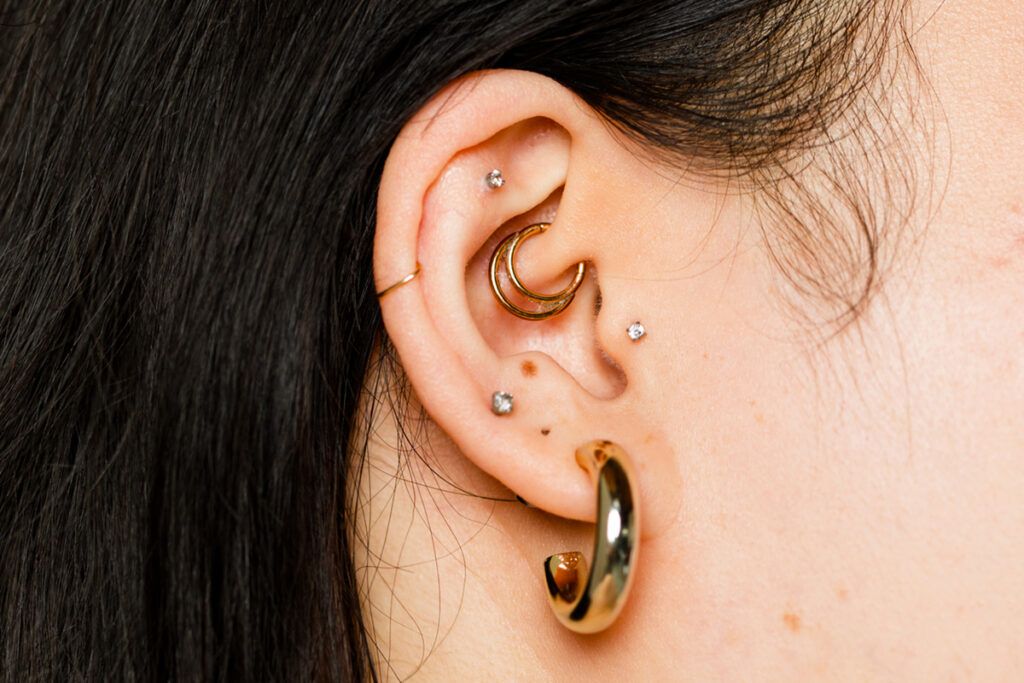A Daith piercing involves inserting jewelry through a specific point in the innermost fold of the ear.
It has become a popular treatment option for migraine, as some believe this piercing may help alleviate symptoms, including frequency and severity.
This article will explore the evidence behind migraine piercing and whether it is a viable treatment option.
Can Daith piercings be effective?

It is proposed that migraine piercing works by stimulating a specific pressure point in the ear or through vagus nerve stimulation, which can help relieve pain and reduce the frequency and severity of migraine.
While anecdotal evidence suggests that daith piercing can reduce migraine symptoms, the evidence is limited and inconclusive. Many studies have had limitations, including small sample size, short duration, and a lack of a control group.
Also, the placebo effect may have contributed to the reported reduction of migraine symptoms. So more research is needed to confirm these findings and understand the mechanisms behind the potential benefits of migraine piercing.
Is a daith piercing safe?
Like any other body piercing, getting a daith piercing carries some risks. The possible risks associated with migraine piercing include:
Infection
The area around the piercing may become red, swollen, and tender, and you may experience discharge or pus. In severe cases, an infection can lead to a fever, and the piercing may need removal.
Pain
Getting a daith piercing can be painful, and some people may experience more discomfort than others. The daith is located in a sensitive ear area, and the piercing needle must pass through a thick cartilage layer, which can be more uncomfortable than a standard earlobe piercing.
Allergic reactions
Some people may be allergic to the metal used in piercing jewelry. This reaction can cause redness, itching, and swelling around the piercing site. If you have a history of metal allergies, it is essential to choose hypoallergenic jewelry to reduce the risk of an allergic reaction.
Keloid scarring
Keloids are raised, thickened scars that form at the site of an injury, including a piercing. Some people are more prone to keloid scarring than others, and the risk may be higher for piercings in cartilage areas like the daith.
Migration and rejection
The body may view the daith piercing as a foreign object and attempt to push it out. This can lead to migration or rejection of the jewelry, where the body gradually pushes the piercing out of the skin.
Recovery
When you get a Daith piercing, the healing process can take 4–12 months. During this time, it’s important to take good care of the piercing to help it heal properly and avoid complications.
To aid in the healing process, follow the aftercare instructions provided by your piercer. These may include:
- cleaning the piercing with saline solution or a gentle, fragrance-free soap twice a day
- avoiding touching or twisting the jewelry
- avoiding activities that may irritate the piercing, such as swimming
In addition to following aftercare instructions, there are a few things you can do to help your body heal, such as:
- eating a balanced diet with plenty of vitamin-rich foods can promote healing and reduce inflammation
- resting and staying hydrated can support your body’s natural healing processes
Alternative treatment methods
Alternative therapies and treatments for migraine symptoms may include:
Acupuncture
Acupuncture involves the insertion of thin needles into specific points of your body. Some studies suggest that acupuncture may help reduce the frequency and intensity of migraine. But more research is needed to understand its effectiveness fully.
Biofeedback
Biofeedback is a technique that helps you become more aware of and gain control over certain bodily functions. It can involve monitoring and controlling muscle tension, heart rate, and other physiological responses. A 2021 study indicates that biofeedback can help manage migraine symptoms, but further research is necessary.
Herbal supplements
Certain herbal supplements, such as feverfew, originating from the daisy plant, have been traditionally used to alleviate migraine. While some studies suggest potential benefits, the evidence is not yet conclusive.
Mindfulness meditation
Mindfulness meditation involves focusing on the present moment and accepting your thoughts and feelings without judgment. A 2020 randomized clinical trial suggests that mindfulness meditation reduces the frequency and severity of episodes, but more research is needed.
Yoga
This traditional practice involves physical postures, breathing exercises, and meditation. A 2022 study suggests that yoga could effectively treat migraine, potentially reducing the frequency and duration of episodes.
While these alternative therapies may offer relief, you should consider talking with a doctor before trying them. They can guide and help you make informed decisions based on your needs.
If you need help covering the cost of medications, the free Optum Perks Discount Card could help you save up to 80% on prescription drugs. Follow the links on drug names for savings on that medication, or search for a specific drug here.
